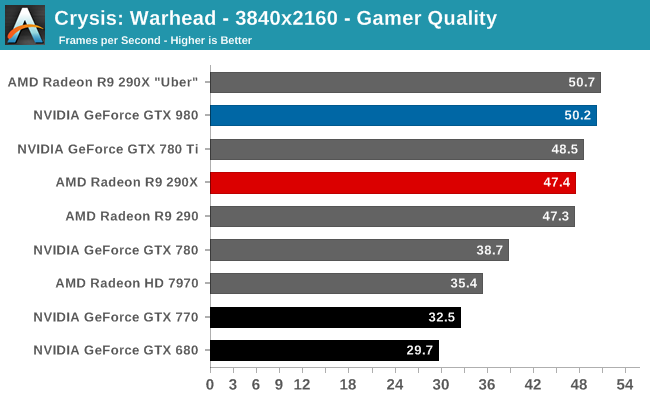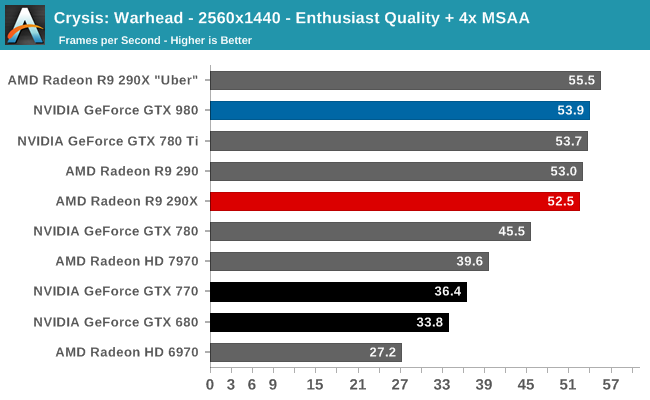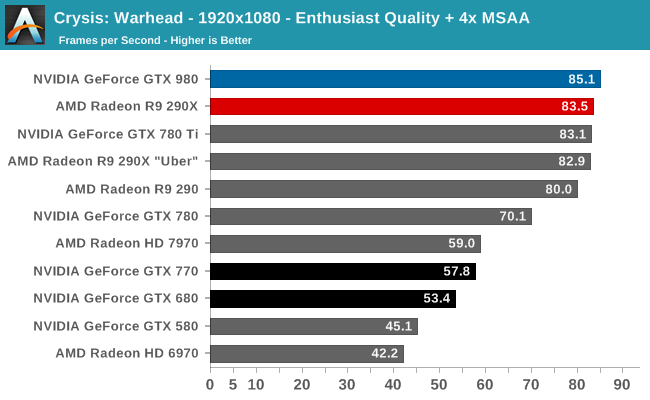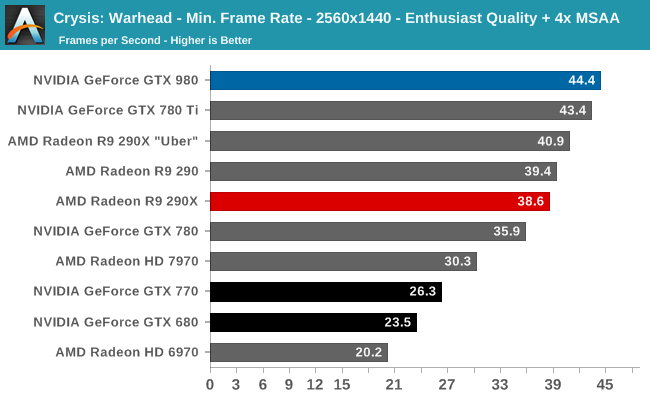The NVIDIA GeForce GTX 980 Review: Maxwell Mark 2
by Ryan Smith on September 18, 2014 10:30 PM ESTCrysis: Warhead
Up next is our legacy title for 2014, Crysis: Warhead. The stand-alone expansion to 2007’s Crysis, at over 5 years old Crysis: Warhead can still beat most systems down. Crysis was intended to be future-looking as far as performance and visual quality goes, and it has clearly achieved that. We’ve only finally reached the point where single-GPU cards have come out that can hit 60fps at 1920 with 4xAA, never mind 2560 and beyond.



At the launch of the GTX 680, Crysis: Warhead was rather punishing of the GTX 680’s decreased memory bandwidth versus GTX 580. The GTX 680 was faster than the GTX 580, but the gains weren’t as great as what we saw elsewhere. For this reason the fact that the GTX 980 can hold a 60% lead over the GTX 680 is particularly important because it means that NVIDIA’s 3rd generation delta color compression is working and working well. This has allowed NVIDIA to overcome quite a bit of memory bandwidth bottlenecking in this game and push performance higher.
That said, since GTX 780 Ti has a full 50% more memory bandwidth, it’s telling that GTX 780 Ti and GTX 980 are virtually tied in this benchmark. Crysis: Warhead will gladly still take what memory bandwidth it can get from NVIDIA cards.
Otherwise against AMD cards this is the other game where GTX 980 can’t cleanly defeat R9 290XU. These cards are virtually tied, with AMD edging out NVIDIA in two of three tests. Given their differing architectures I’m hesitant to say this is a memory bandwidth factor as well, but if it were then R9 290XU has a very big memory bandwidth advantage going into this.



When it comes to minimum framerates the story is much the same, with the GTX 980 and AMD trading places. Though it’s interesting to note that the GTX 980 is doing rather well against the GTX 680 here; that memory bandwidth advantage would appear to really be paying off with minimum framterates.










274 Comments
View All Comments
jmunjr - Friday, September 19, 2014 - link
Wish you had done a GTX 970 review as well like many other sites since way more of us care about that card than the 980 since it is cheaper.Gonemad - Friday, September 19, 2014 - link
Apparently, if I want to run anything under the sun in 1080p cranked to full at 60fps, I will need to get me one GTX 980 and a suitable system to run with it, and forget mid-ranged priced cards.That should put an huge hole in my wallet.
Oh yes, the others can run stuff at 1080p, but you have to keep tweaking drivers, turning AA on, turning AA off, what a chore. And the milennar joke, yes it RUNS Crysis, at the resolution I'd like.
Didn't, by any chance, the card actually benefit of being fabricated at 28nm, by spreading its heat over a larger area? If the whole thing, hipothetically, just shrunk to 14nm, wouldn't all that 165W of power would be dissipated over a smaller area (1/4 area?), and this thing would hit the throttle and stay there?
Or by being made smaller, it would actually dissipate even less heat and still get faster?
Yojimbo - Friday, September 19, 2014 - link
I think that it depends on the process. If Dennard scaling were to be in effect, then it should dissipate proportionally less heat. But to my understanding, Dennard scaling has broken down somewhat in recent years, and so I think heat density could be a concern. However, I don't know if it would be accurate to say that the chip benefited from the 28nm process, since I think it was originally designed with the 20nm process in mind, and the problem with putting the chip on that process had to do with the cost and yields. So, presumably, the heat dissipation issues were already worked out for that process..?AnnonymousCoward - Friday, September 26, 2014 - link
The die size doesn't really matter for heat dissipation when the external heat sink is the same size; the thermal resistance from die to heat sink would be similar.danjw - Friday, September 19, 2014 - link
I would love to see these built on Intel's 14nm process or even the 22nm. I think both Nvidia and AMD aren't comfortable letting Intel look at their technology, despite NDAs and firewalls that would be a part of any such agreement.Anyway, thanks for the great review Ryan.
Yojimbo - Friday, September 19, 2014 - link
Well, if one goes by Jen-Hsun Huang's (Nvidia's CEO) comments of a year or two ago, Nvidia would have liked Intel to manufacture their SOCs for them, but it seems Intel was unwilling. I don't see why they would be willing to have them manufacture SOCs and not GPUs being that at that time they must have already had the plan to put their desktop GPU technology into their SOCs, unless the one year delay between the parts makes a difference.r13j13r13 - Friday, September 19, 2014 - link
hasta que no salga la serie 300 de AMD con soporte nativo para directx 12Arakageeta - Friday, September 19, 2014 - link
No interpretation of the compute graphs whatsoever? Could you at least report the output of CUDA's deviceQuery tool?texasti89 - Friday, September 19, 2014 - link
I'm truly impressed with this new line of GPUs. To be able to acheive this leap on efficiency using the same transistor feature size is a great incremental achievement. Bravo TSMC & Nvidia. I feel comfortable to think that we will soon get this amazing 980 performance level on game laptops once we scale technology to the 10nm process. Keep up the great work.stateofstatic - Friday, September 19, 2014 - link
Spoiler alert: Intel is building a new fab in Hillsboro, OR specifically for this purpose...